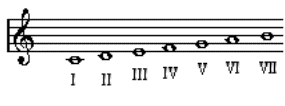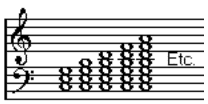Tonality and Scale

I, II, III, IV, V, VI, VII.

Frequently, the degrees are called : root, second, third, fourth, fifth, sixth and seventh.
Origin of the scales
Chords are built by superimposition of thirds. A chord can contain from three to twelve notes.

For methodological reasons, we will start to work with chords built with three notes.
If we represent ourselves our C major scale on a staff, we will be able to start quite naturally to build some chords with three notes.

Note : A stack of two notes is not a chord but a "harmonic interval". We talk about chords from three notes.
According to traditional harmony, these chords are called "Chord of first degree of C major, Chord of 2nd degree of C major, etc.
According to the "Lydian concept", these chords are called C major chord, D minor chord, E minor chord, etc., but for the moment we won't deal with this nomenclature.
We have here a complete range which will enable us to start composing (the word is a little untimely but correct) some small very primary pieces which do not exceed the level of harmony exercise.
To finish for today, I offer you a small sweet. I anticipate a little over future lessons but this little experimentation is intended to show you that indeed, these chords placed like this on a major scale constitute already a whole complete universe which can be used to build a song, from the harmonic point of view.
I give you all the 4-note chords that can be built on the C major scale :

Train yourselves to play those chords with the left hand. It is not a problem because the position is always the same and you just need to move your fore-arm.
A piece of advice for people who aren't keyboard players. Don't try to read the notes on the staff one by one. Learn only the first chord and then, with the hand in the same position - imagine a fork - move it one note by one note at the same time when concentrating yourselves on your fifth finger only.
Play them first in order, then in disorder. You can let down the chord of the VII degree, you will know why later.
Then, have fun to improvise some melodies with the right hand, only on the white keys (tonality of C major) while you play some chords in disorder with the left hand.
Of course, you will find a continuation, a personal order, (a grid if you prefer) whic will satisfy you more than another one. It is very simple for the moment, but you will see that the result starts to take form and that music, really, "functions".





